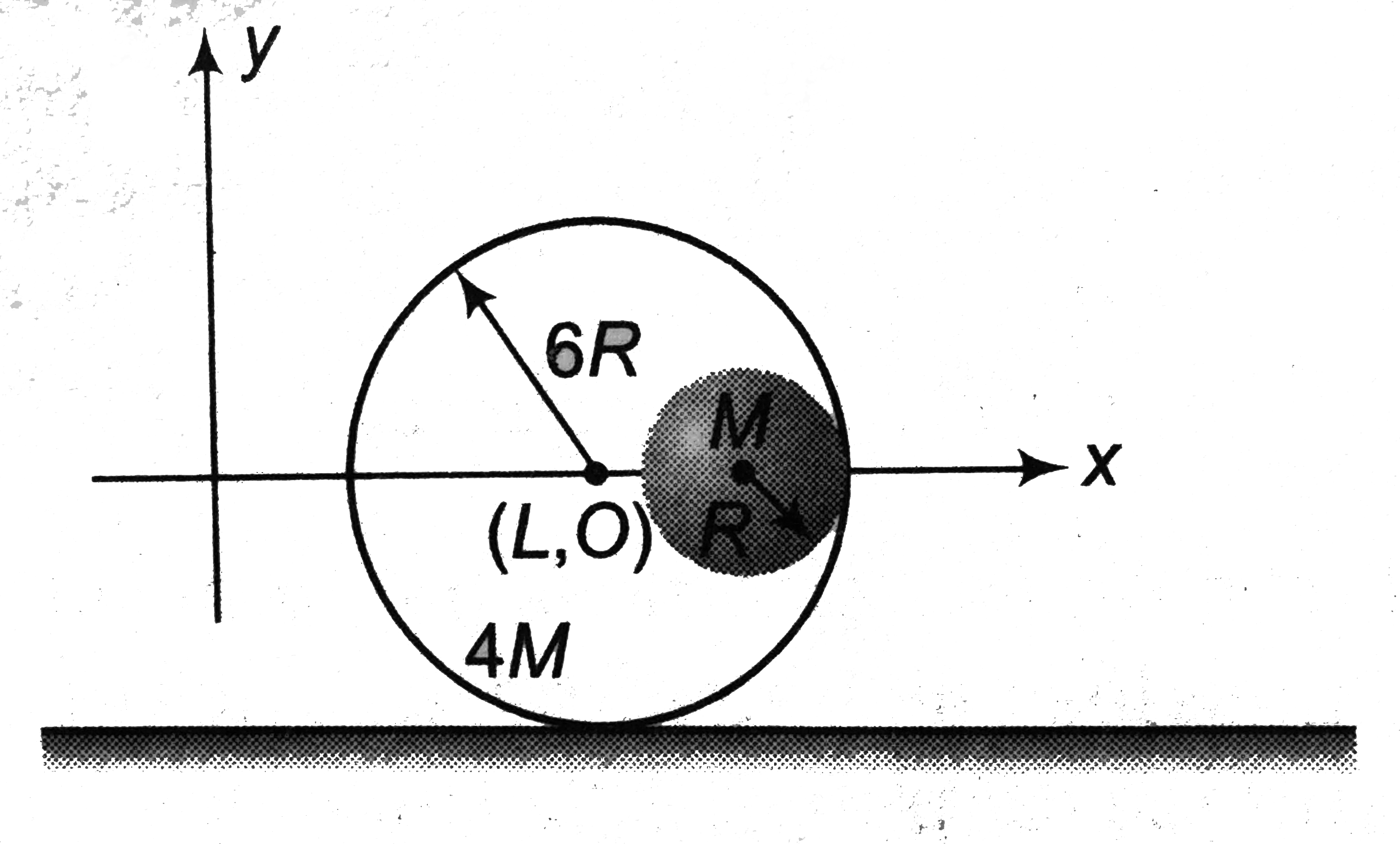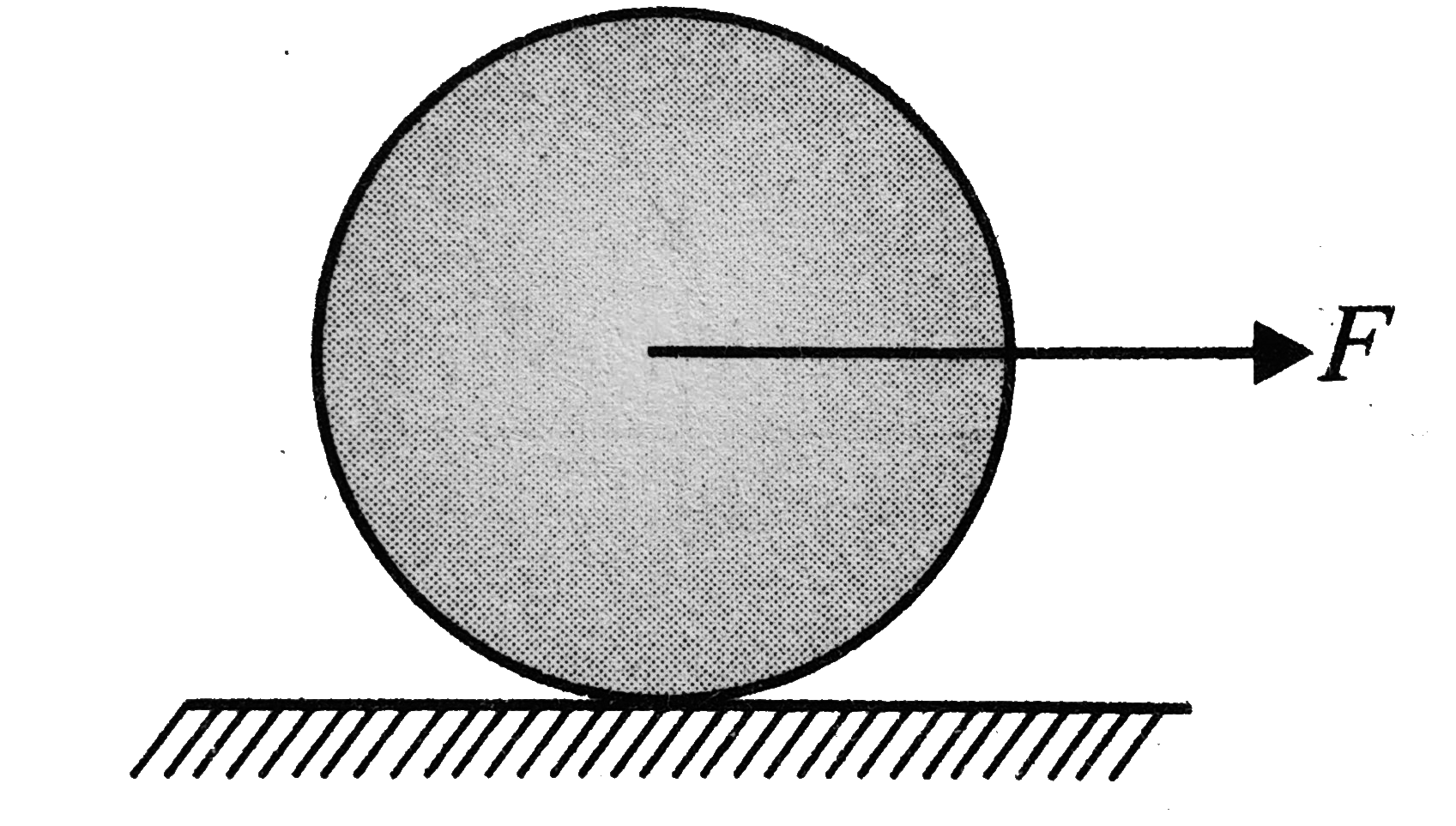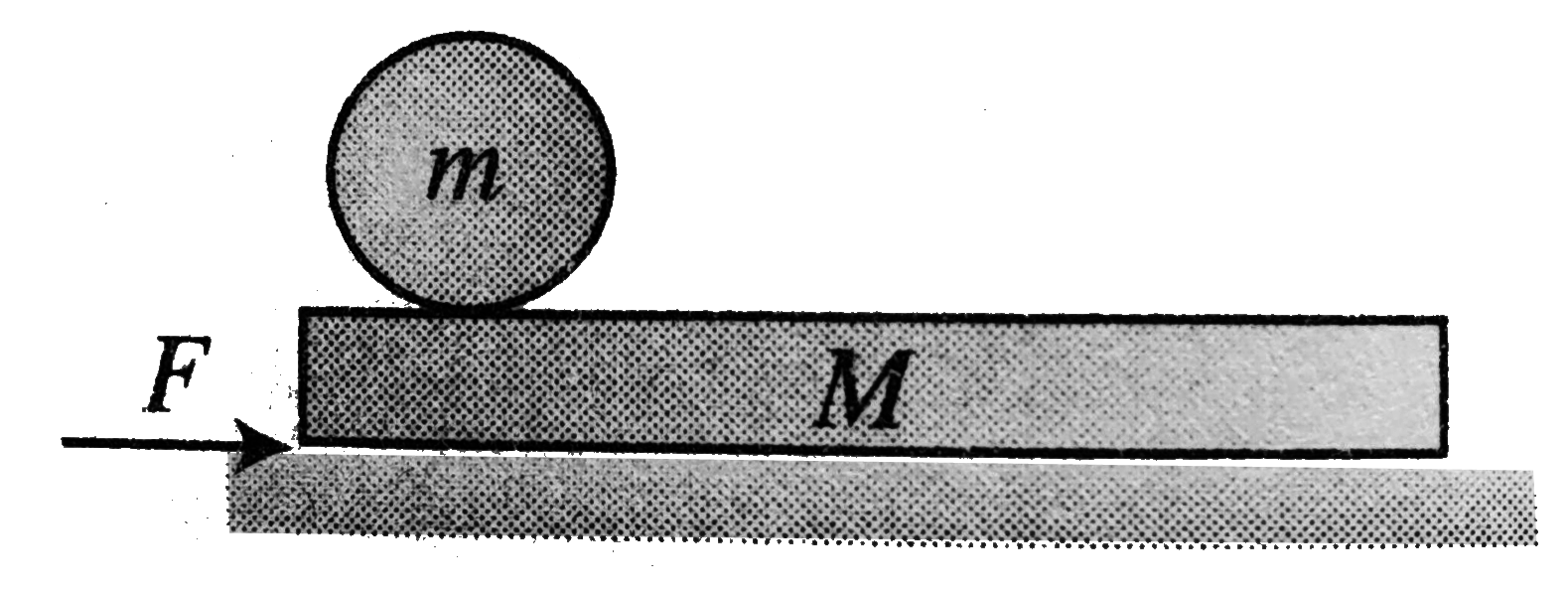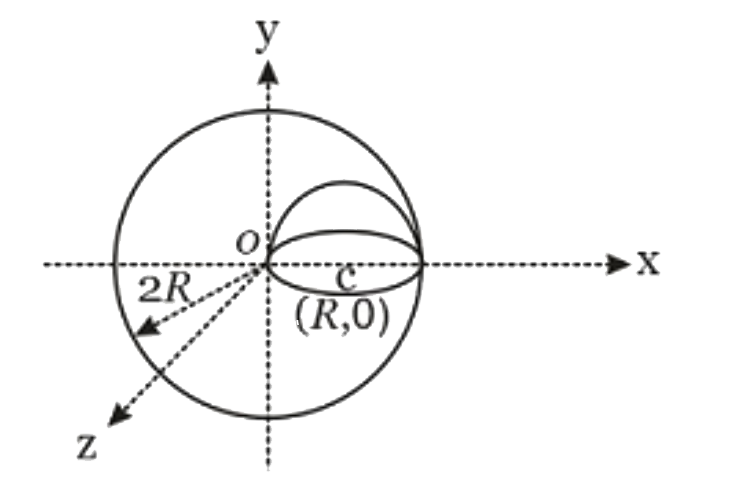A small sphere of radius R is held against the inner surface of a larger sphere of radius 6R. The mass of large and small spheres are 4M and M respectively. This arrangement is placed on a horizontal table. There is no friction between any surface of contact. The small sphere is now released. The x coordinate of the centre of the larger sphere when the smaller sphere reaches the other extreme position, is found to be (L+nR) , find n.
The correct Answer is:2
To solve the problem step by step, we will analyze the motion of the small sphere and the resulting motion of the larger sphere.
Step 1: Understand the initial setup
We have a small sphere of radius R and mass M held against the inner surface of a larger sphere of radius 6R and mass 4M. The center of the larger sphere is at point O on the x-axis, and the small sphere is initially at a distance of 6R−R=5R from the center of the larger sphere.
Step 2: Determine the initial position of the center of mass
The initial position of the center of mass xi can be calculated using the formula for the center of mass of a system:
xi=m1x1+m2x2m1+m2
Where:
- m1=4M (mass of the larger sphere)
- m2=M (mass of the smaller sphere)
- x1=L (x-coordinate of the center of the larger sphere)
- x2=L+5R (x-coordinate of the small sphere)
Substituting these values:
xi=(4M)(L)+(M)(L+5R)4M+M
xi=4ML+ML+5MR5M=5ML+5MR5M=L+R
Step 3: Determine the final position of the center of mass
When the small sphere is released, it will roll to the other extreme position against the inner surface of the larger sphere. The final position of the small sphere will be at a distance of 6R−R=5R from the center of the larger sphere, but now it will be on the opposite side.
The final position of the small sphere can be represented as:
x′2=L−5R
Now, we can find the final position of the center of mass xf:
xf=(4M)(L)+(M)(L−5R)4M+M
xf=(4ML)+(ML−5MR)5M=4ML+ML−5MR5M=5ML−5MR5M=L−R
Step 4: Set the initial and final center of mass equal
Since there are no external forces acting on the system, the center of mass remains constant:
xi=xf
Substituting the values we found:
L+R=L−R
Step 5: Solve for n
From the equation xf=L+nR, we can equate:
L−R=L+nR
Subtracting L from both sides gives:
−R=nR
Dividing both sides by R (assuming R≠0):
−1=n
Conclusion
The value of n is −1.
We have a small sphere of radius R and mass M held against the inner surface of a larger sphere of radius 6R and mass 4M. The center of the larger sphere is at point O on the x-axis, and the small sphere is initially at a distance of 6R−R=5R from the center of the larger sphere.
The initial position of the center of mass xi can be calculated using the formula for the center of mass of a system:
xi=m1x1+m2x2m1+m2
Where:
- m1=4M (mass of the larger sphere)
- m2=M (mass of the smaller sphere)
- x1=L (x-coordinate of the center of the larger sphere)
- x2=L+5R (x-coordinate of the small sphere)
xi=(4M)(L)+(M)(L+5R)4M+M
xi=4ML+ML+5MR5M=5ML+5MR5M=L+R
When the small sphere is released, it will roll to the other extreme position against the inner surface of the larger sphere. The final position of the small sphere will be at a distance of 6R−R=5R from the center of the larger sphere, but now it will be on the opposite side.
x′2=L−5R
Now, we can find the final position of the center of mass xf:
xf=(4M)(L)+(M)(L−5R)4M+M
xf=(4ML)+(ML−5MR)5M=4ML+ML−5MR5M=5ML−5MR5M=L−R
Since there are no external forces acting on the system, the center of mass remains constant:
xi=xf
Substituting the values we found:
L+R=L−R
From the equation xf=L+nR, we can equate:
L−R=L+nR
Subtracting L from both sides gives:
−R=nR
Dividing both sides by R (assuming R≠0):
−1=n
The value of n is −1.
Topper's Solved these Questions
- BOOK - VMC MODULES ENGLISHCHAPTER - ENERGY & MOMENTUMEXERCISE - JEE ADVANCE (ARCHIVE) - PARAGRAPH QUESTIONS5videos
ENERGY & MOMENTUM
- BOOK - VMC MODULES ENGLISHCHAPTER - ENERGY & MOMENTUMEXERCISE - JEE ADVANCE (ARCHIVE) - ASSERTION & REASON TYPE1videos
ENERGY & MOMENTUM
- BOOK - VMC MODULES ENGLISHCHAPTER - ENERGY & MOMENTUMEXERCISE - JEE MAIN (ARCHIVE)53videos
ENERGY & MOMENTUM
- BOOK - VMC MODULES ENGLISHCHAPTER - ELECTROSTATICSEXERCISE - JEE Advanced (Archive)89videos
ELECTROSTATICS
- BOOK - VMC MODULES ENGLISHCHAPTER - GASEOUS STATE & THERMODYNAMICSEXERCISE - JEE ADVANCED (ARCHIVE )111videos
GASEOUS STATE & THERMODYNAMICS
Similar Questions
A small sphere of radius R is held against the inner surface of larger sphere of radius 6R (as shown in figure). The masses of large and small spheres are 4M and M respectively. This arrangement is placed on a horizontal table. There is no friction between any surfaces of contact. The small sphere is now released. Find the coordinates of the centre of the large spheres, when the smaller sphere reaches the other extreme position.
 View Solution
View SolutionA small sphere of radius R is held against the inner surface of larger sphere of radius 6R (as shown in figure). The masses of large and small spheres are 4M and M respectivley. This arrangement is placed on a horizontal table. There is no friction between any surfaces of contact. The small sphere is now released. Find the coordinates of the centre of the large spheres, when the smaller sphere reaches the other extreme position.
 View Solution
View SolutionA small conducting sphere of radius r is lying concentrically inside a bigger hollow conducting sphere of radius R. The bigger and smaller spheres are charged with Q and q(Q>q) and are insulated from each other. The potential difference between the spheres will be
View SolutionA hollow sphere of radius 2R is charged to V volts and another smaller sphere of radius R is charged to V/2 volts. Now the smaller sphere is placed inside the bigger sphere without changing the net charge on each sphere. The potential difference between the two spheres would be
View SolutionThree identical spheres each of radius .R. are placed on a horizontal surface touching one another. If one of the spheres is removed, the shift in the centre of mass of the system is
View SolutionA solid sphere of mass m is lying at rest on a rough horizontal surface. The coefficient of friction between the ground and sphere is μ. The maximum value of F, so that the sphere will not slip, is equal to
 View Solution
View SolutionA sphere of mass m and radius r is placed on a rough plank of mass M. The system is placed on a smooth horizontal surface. A constant force F is applied on the plank such that the sphere rolls purely on the plank. Find the acceleration of the sphere.
 View Solution
View SolutionA hemispherical cavity of radius R is created in a solid sphere of radius 2R as shown in the figure . They y -coordinate of the centre of mass of the remaining sphere is
 View Solution
View SolutionA sphere of radius R and charge Q is placed inside an imaginary sphere of radius 2R whose centre coincides with the given sphere. The flux related to imaginary sphere is:
View SolutionA chain of length l and mass m lies on the surface of a smooth sphere of radius R>l with one end tied to the top of the sphere.
View Solution

